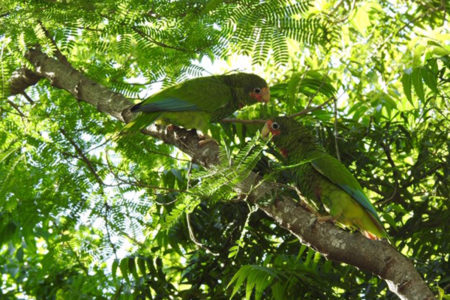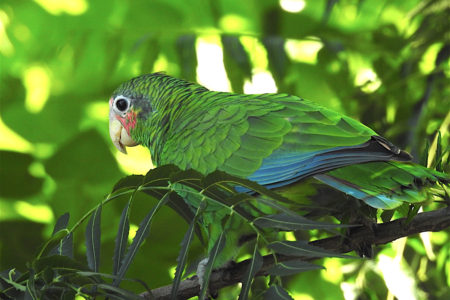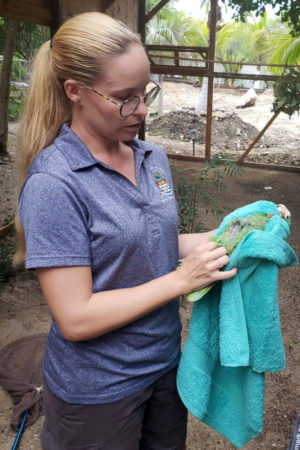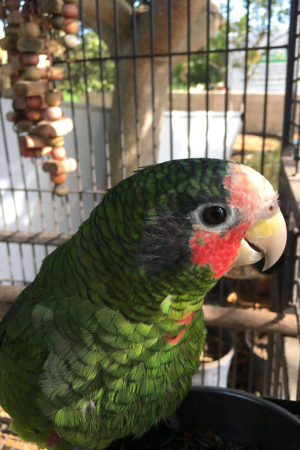
The Cayman Islands Government is urging residents who are keeping Cayman Parrots as pets to have their birds registered with the Department of Environment (DoE) before February 29th, 2020. This amnesty is part of the Government’s efforts to reduce poaching and prevent further decline in the wild parrot populations on Grand Cayman and Cayman Brac.
The Grand Cayman Parrot (Amazona leucocephala caymanensis) and the Cayman Brac Parrot (A.l. hesterna), both represent the national bird of the Cayman Islands. The local name is “Cayman Parrot” but these parrots are a subspecies of the Cuban Parrot, which occurs in Cuba, the Bahamas and the Cayman Islands and was formerly called the Rose-throated Parrot (read more on eBird Caribbean).
The Grand Cayman Parrot is generally green, with a white forecrown, white eye-rings, red cheeks (depending on whether male or female), black ear patches and blue wing feathers which are only seen in flight. Their tails are green with blue edges and red and yellowish-green underneath. The Cayman Brac Parrot is smaller in size and has a more pure white forehead with a large maroon area on its abdomen.

As is typical of parrots, they are active during the early morning, when they go out in search of fruits and berries. During the breeding season they look for food as well as tree cavities in which to raise their young. When resting quietly after their morning activities, they ‘comb’ and clean their feathers using their beaks. It is almost impossible to spot them at this time as they are perfectly camouflaged among the leaves of the trees. In the late afternoon they return to their roost.
The Cayman Brac Parrot previously inhabited Little Cayman but its prime nesting sites were destroyed in the Storm of 1932. It now has the smallest known range of any Amazon parrot in the world. Its survival depends entirely on the protection of remaining old-growth forest which can still be found on Cayman Brac.
Natural disasters such as hurricanes are a threat to the Cayman parrots’ survival—but not the only one. Habitat loss through development and trapping for the illegal pet trade also jeopardize the future of these birds.

These parrots have been highly sought “gifts” and pets, even though they are protected by law. It is illegal to trap, sell and keep the birds in captivity. Yet, many people still keep them as pets. In an effort to curb the illegal trade in the national bird, the DoE set up a six month amnesty program, running from September 1st 2019 to February 29th 2020. Pet parrot owners can now legally register their birds without the risk of their pets being taken away.
Each pet parrot will be checked by a veterinarian, given an identification number printed on a small band around the parrot’s leg and implanted with an identification chip, similar to the ID tags used to register dogs and cats, at no cost to the owner.
About a year ago, the DoE started a collaboration with a private member of the public to open a much-needed Parrot Sanctuary in East End. The Cayman Parrot Sanctuary boasts native plants and trees. Parrots that are not yet able to return to the wild are housed in secure, clean and spacious aviaries. The Sanctuary is managed by Australian-born Ron Hargrave, who is very much invested in the conservation and well-being of parrots and Cayman wildlife.
The Sanctuary takes in injured parrots and provides rehabilitative care, with the goal of releasing the birds back into the wild population. The birds have a much higher chance of survival in the wild following releases from the sanctuary. They are given thorough medical exams and their health is continuously monitored. Parrots are also taught how to be wild birds again. They have natural foods to eat and learn where to find them; they are also able to form social bonds with other parrots.

Following every release, the birds are provided with temporary supplemental feeding stations. Their behavior and movements are monitored in the wild. To date seven parrots have been released.
Not all parrots can be released back into the wild. Therefore, pet parrot owners are discouraged from releasing their pet birds themselves. They should instead contact the DoE. Also, if you are a Cayman Parrot owner but have not yet registered your bird, please call Jane Håkonsson on 925-1807 or 949-8469 or email doe@gov.ky.
Spread the word and help protect the Cayman Islands’ national bird for generations to enjoy!
Special thanks to Aliya Hosein (Leader of the Welfare and Wildlife Program at the Centre for the Rescue of Endangered Species of Trinidad and Tobago) and Jane Ebert Håkonsson (Cayman Islands’ Department of Environment Research Officer) for this blog article!

Very informative article.
Hello Momina, Glad you found the article information, thanks for reading!
What a creative solution to add to the conservation “toolbox,” as they say. I look forward to learning more about these programs, how many birds they register, and their overall success. And hooray for the sanctuary too!
Thanks for your comment Steve, we agree, and hope that more programs like this will be offered in other countries. We will keep you and our readers informed on the results. Thanks for reading and all the best, Lisa Sorenson